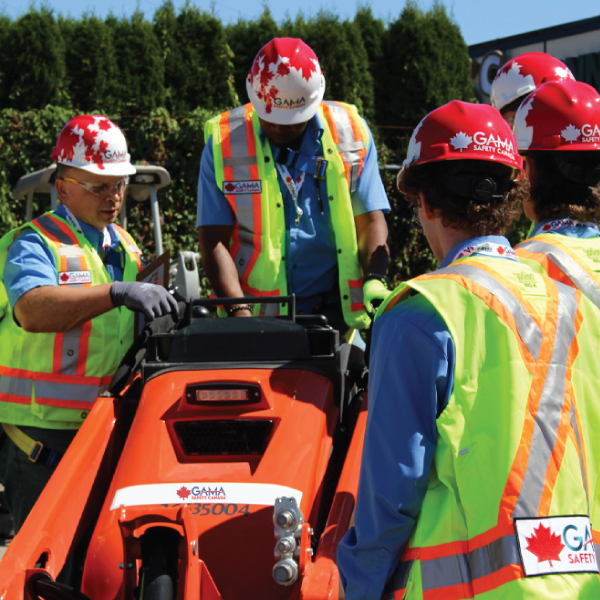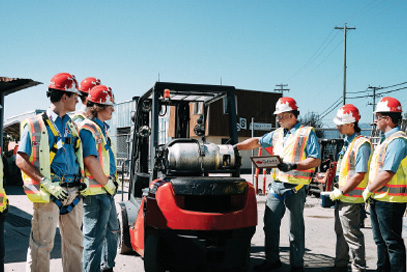Safe Operation of Skid Steer
Loaders in Confined Work Areas
Skid Steer loaders are versatile machines commonly used for digging, lifting, and hauling materials in tight spaces. They require specialized training for safe operation, including maneuvering in uneven terrain, operating attachments, and understanding load capacity to avoid accidents and equipment damage.
Safe Operation of Skid Steer
Loaders in Confined Work Areas
Skid Steer loaders are versatile machines commonly used for digging, lifting, and hauling materials in tight spaces. They require specialized training for safe operation, including maneuvering in uneven terrain, operating attachments, and understanding load capacity to avoid accidents and equipment damage.
OUR PARTNERS AROUND THE WORLD
OUR PARTNERS AROUND THE WORLD
OUR PARTNERS AROUND THE WORLD
OUR PARTNERS AROUND THE WORLD
OUR PARTNERS AROUND THE WORLD
OUR PARTNERS AROUND THE WORLD
OUR PARTNERS AROUND THE WORLD
OUR PARTNERS AROUND THE WORLD
OUR PARTNERS AROUND THE WORLD
OUR PARTNERS AROUND THE WORLD
OUR PARTNERS AROUND THE WORLD
OUR PARTNERS AROUND THE WORLD
OUR PARTNERS AROUND THE WORLD
OUR PARTNERS AROUND THE WORLD
Skid Steer
Introduction
Learn the basic functions of the Skid Steer Loader, from cab entry to safe startup and initial maneuvering techniques.
Working Zones
& Safety
Understand visibility, blind spots, turning zones, and common hazards while operating a skid steer in tight spaces.
Skid Steer Safety Resources
Video resources for safe operation and hazards associated with skid steers.
Standards and safety requirements for operating skid steers and other mobile equipment.
Regulations covering skid steer stability, load handling, and safe operational procedures.
Skid Steer Fundamentals:
Best Practices for Safe Equipment Operation
Understanding the fundamentals of Skid Steer operation is essential for ensuring both safety and efficiency on the job site. These compact loaders are powerful and versatile machines, but without proper training and technique, they can quickly become hazardous. Mastering the basics from machine controls to situational awareness is the first step in preventing accidents.

SKID STEER
Skid Steer Essentials:
Safe Operation of Compact Loaders
Operating a Skid Steer demands attention to detail, spatial awareness, and a deep understanding of safety practices. These compact loaders are powerful and highly maneuverable, but improper use can lead to accidents, property damage, or serious injuries. That’s why proper training is essential for anyone working with or around this equipment.
This course focuses on the core principles of Skid Steer safety, including machine inspection, stability, safe entry and exit, and effective communication on the job site. Participants will learn how to assess terrain conditions, understand load capacities, and apply defensive operating techniques to protect themselves and their coworkers.
By completing this training, workers will be better equipped to operate Skid Steers in compliance with Canadian safety regulations. The goal is to promote confidence, reduce risk, and ensure that every job involving a compact loader is completed safely and efficiently.
SKID STEER Definition
A Skid Steer is a compact, rigid-framed machine designed for construction, landscaping, agriculture, and industrial applications. It is equipped with lift arms that can be fitted with a wide range of attachments, such as buckets, pallet forks, or hydraulic augers. The defining feature of a skid steer is its unique steering system, which allows the machine to turn by skidding the wheels or tracks on either side at different speeds or directions. This gives it an exceptional turning radius and maneuverability, even in very tight spaces.
These machines are highly valued for their versatility, as they can perform many different tasks with a single unit. Their compact design makes them ideal for use in areas where space is limited, and their ability to support numerous attachments means they can take on various roles on the job site. Whether it’s moving materials, grading surfaces, or clearing snow, Skid Steers are among the most adaptable pieces of equipment in the industry.
A Skid Steer operates using a dual drive system, where each side of the machine (left and right wheels or tracks) is independently controlled. Instead of turning with a traditional steering wheel, the operator maneuvers the equipment by adjusting the speed and direction of each side. When the wheels on one side move faster than the other or in the opposite direction the machine turns or pivots. This skid-style steering allows for zero-radius turns, making the equipment especially effective in confined or indoor spaces.
Operators control the skid steer from a seated position inside the operator cab, typically using joysticks, pedals, or hand levers. The cab is usually equipped with safety features such as seat belts, ROPS (Rollover Protective Structures), and sometimes FOPS (Falling Object Protective Structures). Learning to control the machine smoothly is critical to avoiding sudden movements or jerks, especially when handling loads or navigating uneven terrain. Training and hands-on experience are vital for safe and efficient operation.
Skid Steers are used in a wide variety of industries and job functions, primarily because of their ability to perform many different tasks with the right attachment. In construction, they are commonly used for digging, trenching, grading, backfilling, and lifting materials. In landscaping, they assist in tasks such as soil preparation, sod installation, and moving heavy objects like stones or trees. Their compact footprint allows them to operate efficiently in backyards, between buildings, and in other tight job sites where larger machines cannot maneuver.
In addition to earthmoving, Skid Steers are also used for cleanup and material handling tasks. They can be outfitted with brooms for sweeping debris, snow blowers for winter maintenance, or forks for moving pallets. With hydraulic tool compatibility, they can even power tools like trenchers or stump grinders. The broad range of uses makes them a smart investment for companies looking to maximize versatility with minimal equipment.
One of the most important features of a Skid Steer is its size-to-power ratio. Despite being compact, skid steers offer substantial lifting and digging capacity, and their small size makes them perfect for urban or indoor projects. Their rigid frame provides strength and durability under pressure, and their lift arms enable both vertical and radial lifting, depending on the model. Some models use wheels, while others are track-based, depending on the ground conditions they’re designed for.
Other key features include the operator’s cab, which is often enclosed and climate-controlled for comfort and safety. Most cabs include easy-to-use controls, safety locks, and excellent visibility. The hydraulic system is another essential component, allowing for quick attachment changes and the operation of powerful hydraulic tools. Some newer models also include digital displays, onboard diagnostics, and GPS capabilities to help operators optimize performance and efficiency on the job.
The term "Skid Steer" comes from the machine’s distinctive method of turning. Unlike traditional vehicles, which use a steering wheel and pivoting wheels, a skid steer turns by skidding or dragging its fixed wheels or tracks across the ground. This is achieved by varying the speed or direction of the wheels on either side of the machine. When one side moves forward and the other moves in reverse, the machine pivots in place, allowing for extremely sharp turns and excellent control in confined areas.
This steering system is what gives the skid steer its agility and makes it especially useful in environments with restricted movement space. However, the skidding motion can put additional wear on the tires and ground surfaces, which is why operators must be trained to use it effectively. This unique steering design also increases the need for precision, making proper training essential to avoid ground damage, tipping, or unsafe turning while carrying loads.
One of the biggest advantages of using a Skid Steer is its ability to support a wide variety of attachments. These include buckets for digging or transporting material, pallet forks for moving loads, augers for drilling holes, sweepers for cleaning surfaces, and snow blowers or blades for winter tasks. Other specialized tools include stump grinders, trenchers, hydraulic hammers, and concrete mixers. Attachments are typically connected to the lift arms and powered by the skid steer’s hydraulic system.
The quick-attach system used on most modern skid steers allows operators to switch between tools quickly and safely, often without leaving the cab. This flexibility saves time, reduces the need for multiple machines, and allows companies to complete a broader range of tasks with one piece of equipment. Proper training is essential to ensure that attachments are used correctly and safely, including checking compatibility, securing locks, and understanding operational limits.
SKID STEER Legislation
The use of Skid Steers in Canada is primarily regulated under provincial and territorial occupational health and safety legislation. For example, in British Columbia, WorkSafeBC outlines specific standards for mobile equipment under Part 16 of the Occupational Health and Safety Regulation. Federally regulated workplaces follow the Canada Labour Code and associated regulations such as the Canada Occupational Health and Safety Regulations (COHSR), which provide safety requirements for operating powered mobile equipment.
These regulations are designed to ensure the safe operation of Skid Steers, requiring employers to provide proper training, conduct regular maintenance, and implement safe work procedures. Operators must be competent and aware of hazards such as rollovers, tip-overs, collisions, and entrapment. Legislative compliance includes following safe operating procedures, wearing personal protective equipment (PPE), and conducting pre-operation inspections.
Yes, training is legally required for all Skid Steer operators in Canada. Under occupational health and safety legislation, employers must ensure that workers who operate mobile equipment are trained, qualified, and competent. This includes both theoretical knowledge and practical skill assessments. In many provinces, such as Ontario and Alberta, employers must document training records and re-evaluate operator competency on a regular basis.
Training must cover safe operation, hazard recognition, emergency response, and the use of specific attachments. It must also address the unique risks associated with skid steers, including visibility limitations, tight turning radii, and load balancing. Regulatory bodies like WorkSafeBC, the Ministry of Labour, or Alberta OHS may request proof of operator certification during inspections or investigations.
Yes, pre-operational inspections are mandatory and are outlined in workplace safety legislation across Canada. Before using a Skid Steer, the operator must complete a full visual and functional inspection to ensure the machine is in safe working condition. This includes checking fluid levels, tires or tracks, brakes, steering, hydraulics, warning lights, and attachment fittings. Any defect or issue must be reported and addressed before operation.
Most provinces require that these inspections be documented and retained by the employer. Not only does this meet compliance requirements, but it also supports preventive maintenance, reduces machine downtime, and helps avoid costly incidents caused by equipment failure. Failure to inspect can result in legal penalties, work stoppages, or worker injuries making this a critical safety obligation.
Under Canadian health and safety laws, employers are legally responsible for ensuring that Skid Steer operations are conducted safely. This includes providing adequate training, ensuring equipment is maintained and inspected, and developing site-specific safe work procedures. Employers must also identify hazards associated with skid steer use and implement controls to eliminate or minimize risk.
Additionally, employers are required to supply appropriate PPE, provide supervision, and ensure only competent and authorized personnel operate the equipment. In the event of an incident or injury, failure to fulfill these responsibilities can lead to fines, legal liability, and even criminal charges under the Westray Bill (Bill C-45), which holds employers accountable for negligence in workplace safety.
Yes, Canadian regulations require that all Skid Steers be equipped with a seat belt and a Rollover Protective Structure (ROPS). These features are critical for operator protection in the event of a rollover or collision. The ROPS must meet the standards set by organizations such as CSA (Canadian Standards Association) or ANSI, depending on the jurisdiction. The seat belt must be worn at all times when the machine is in use.
Legislation mandates that employers ensure these safety features are not only present but also functional and properly maintained. Disabling or removing ROPS or seat belts is strictly prohibited and can result in serious penalties during a workplace inspection. Operators must be trained to use these systems correctly and understand their importance in preventing fatal injuries during machine tip-overs.
Non-compliance with Skid Steer safety regulations can lead to a range of serious consequences, including administrative penalties, worksite shutdowns, fines, and legal prosecution. Provincial regulators like WorkSafeBC, the Ontario Ministry of Labour, or Alberta Occupational Health and Safety regularly inspect workplaces for violations and unsafe practices. If non-compliance is found, stop-work orders may be issued until corrective actions are taken.
In the case of a workplace incident resulting from regulatory breaches, the employer could face civil liability, higher insurance premiums, and reputational damage. In severe cases, criminal charges can be laid under Bill C-45, which allows for prosecution of individuals or companies for workplace negligence. Staying compliant not only protects your workers it protects your business from legal and financial risk.
Other Courses You May Be Interested In.
Workers who complete SKID STEER training often continue their safety education with the following programs:"
More Courses
Online Courses
"Explore & Book Online Courses!
Have a Question?
"We’re here to help! Click the button to get in touch."


